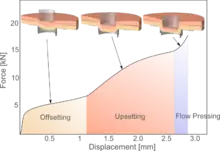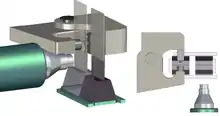Clinching
Clinching or press-joining is a bulk-sheet metal-forming process aimed at joining thin metal sheet without additional components, using special tools to plastically form an interlock between two or more sheets. The process is generally performed at room temperature but in some special cases the sheets can be pre-heated to improve the material ductility and thereby avoid the formation of cracks during the process. Clinching is characterized by a series of advantages over competitive technologies:[1]
- Reduced joining time (the joining time is less than a second);
- Reduced cost and weight: the process does not involve additional elements such as screws, rivets or adhesives
- Reduced cost of the machine;
- No pre-holes are required;
- Can be adopted to join different materials including metals, polymers, wood, and composite materials;
- Can be easily automated and does not require qualified workers;
- Eco-friendly: it does not require pretreatments with solvents, acids, and other harmful liquids;
- The mechanical strength of the metal material near the joint is generally increased due to work-hardening;
- Cleanness: the process does not produce flashes or fumes;
- Repeatability;
- Flexibility: the same tools can be employed for a wide series of materials
- Reduced joining forces

Tools
Because the process involves relatively low forces (ranging from 5 to 50 kN depending on the material to join, type of tools and sheet thicknesses), clinching generally involves reduced size (often portable) machines. The tools typically consist of a punch and a die. Different tools have been developed so far, which can be classified in round and rectangular tools. Round clinching tools include: fixed grooved dies, split dies (with 2–4 movable sectors) and flat dies. Such tools produce round joints which show almost identical mechanical behaviors in all plane directions. When round tools are adopted, the integrity of the sheet in the joint must be guaranteed in order to preserve a good mechanical behavior of the joints.

On the other hand, rectangular clinched joints exhibit behaviors which depend on the loading direction and both sheets are intentionally sheared along the "long direction" in order to produce the interlock. The choice of the tools is highly influenced by:
- Material ductility
- Loading direction
- Thickness of the sheets
In addition, the choice of the clinching tools highly affects the joining strength and the absorbed energy of a clinched connection other than the joining force. Rectangular tools, for example, require lower joining forces than round tools since the material shearing, while among the round clinching tools split dies require the minimum joining force and the largest interlock.[1]
One benefit of clinching is the capability to join prepainted sheet metal commonly used in the appliance industry without damaging the painted surface. Clinching is an important means of fastening aluminum panels, such as hoods and decklids, in the automotive industry, due to the difficulty of spot welding of aluminum.[1]
Main advantages as compared to welding
Clinching is used primarily in the automotive, appliance and electronic industries, where it often replaces spot welding. Clinching does not require electricity or cooling of the electrodes commonly associated with spot welding. Being a mechanical joining process, clinching can be used to join materials showing no electrical conductivity such as polymers[2][3] or plastic-metal composites.[1] In addition, it does not require a substrate preparation such as pre-cleaning of surfaces which is required for welding processes. This fact contributes to reduce the joining costs and the environmental impact (since chemical cleaning is not required). Clinching does not generate sparks or fumes. The strength of a clinched joint can be tested non-destructively using a simple measuring instrument to measure the remaining thickness at the bottom of the joint, of the diameter of the produced button depending on the type of tools employed. Life expectancy for clinching tools is in the hundreds of thousands of cycles, making it an economical process. Clinched connections performed on aluminum sheets have higher fatigue life as compared to spot welding.[1][4]
Main advantages as compared to adhesive joining
Clinching does not require a pre-cleaning of the surfaces, which is needed before applying adhesives. Clinching is almost an instant joining process (the required joining time is lower than a second) while adhesive joining often requires a much longer time mainly owing to the curing of the joint (up to many hours). Clinched joints are less affected by environmental agents and effect of aging.
Main limitations
Being a joining method based on the plastic deformation of the sheets, the main limitation of clinching is represented by the sheet material formability (ductility). Since metal ductility increases with temperature, heat assisted clinching processes have been developed, thus increasing the material ductility and extending the clinching "join ability". In addition, increasing the joining temperature results in a reduction in the material's yield stress and consequently a reduction of the required joining force. Nevertheless, if prolonged heating is applied, an increase in the grain size as well as metallurgical changes of alloys may affect the mechanical behavior of the material at the joint vicinity.[5] Different heating systems have been employed to heat the sheets before clinching:
- Convective heating: this represents the cheapest solution and is suitable for a wide range of materials including metals and polymers (thermoplastics). It was used to join aluminum sheets[1][5] and polymer sheets[2][6]
- Inductive heating offers a fast heating solution, which allows to concentrate the heat flux to a reduced area. This method has been can be applied to metallic materials, such as magnesium alloys.[1]
- Flame heating.

Materials
Although clinching has been widely employed for joining ductile metals including
- low-carbon steel,[7][8]
- aluminium,[1][5]
- copper alloys[1]
it has recently extended to other metals, such as
- magnesium and its alloys;[1]
- aluminium with reduced ductility (AA6082-T6);[1][5]
- high-strength low-alloy steel;[1]
- titanium alloys;[1]
and non-metallic materials, such as
References
| Wikimedia Commons has media related to Clinching. |
- He, Xiaocong (2017). "Clinching for sheet materials". Science and Technology of Advanced Materials. 18 (1): 381–405. doi:10.1080/14686996.2017.1320930. PMC 5468947. PMID 28656065.
- Lambiase, F. (2015). "Joinability of different thermoplastic polymers with aluminium AA6082 sheets by mechanical clinching". The International Journal of Advanced Manufacturing Technology. 80 (9–12): 1995–2006. doi:10.1007/s00170-015-7192-1.
- Lambiase, F. (2015). "Mechanical behaviour of polymer-metal hybrid joints produced by clinching using different tools". Materials & Design. 87: 606–618. doi:10.1016/j.matdes.2015.08.037.
- Mori, K.; et al. (2012). "Mechanism of superiority of fatigue strength for aluminium alloy sheets joined by mechanical clinching and self-pierce riveting". Materials Processing Technology. 212 (9): 1900–1905. doi:10.1016/j.jmatprotec.2012.04.017.
- Lambiase, F. (2015). "Clinch joining of heat-treatable aluminum AA6082-T6 alloy under warm conditions". Journal of Materials Processing Technology. 225: 421–422. doi:10.1016/j.jmatprotec.2015.06.022.
- Lambiase, F.; Di Ilio, A. (2015). "Mechanical clinching of metal–polymer joints". Journal of Materials Processing Technology. 215: 12–19. doi:10.1016/j.jmatprotec.2014.08.006.
- Lambiase, F.; Di Ilio, A. (2013). "Finite Element Analysis of Material Flow in Mechanical Clinching with Extensible Dies". Journal of Materials Engineering and Performance. 22 (6): 1629–1636. Bibcode:2013JMEP...22.1629L. doi:10.1007/s11665-012-0451-5.
- Lambiase, F. (2012). "Influence of process parameters in mechanical clinching with extensible dies". The International Journal of Advanced Manufacturing Technology. 66 (9–12): 2123–2131. doi:10.1007/s00170-012-4486-4.
